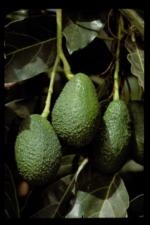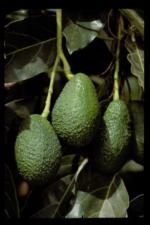Advice for the Home Gardener From the Help Desk of the
UC Master Gardener Program of Contra Costa County
Client's Situation and Request: We have a male and female avocado tree likely ~2.5 years old (we moved to our new home in Moraga, CA ~1.5 years earlier) adjacent to each other on a slope. This past year, there was only one fruit albeit the size of a man's palm (greenish-black, Hass?). This year, although there were several hundred blossoms, the tree again bore one fruit. Presumably because of heavy rains early in the year (~60-inches per the St Mary's weather station), the leaves turned yellow/spotted black and fell off...but we do currently have a profusion of large green leaves. So what do I need to do to increase crop? is it a fertilization issue and/or inadequate N application? or is it the young age of the trees? Your feedback would be much appreciated as we were planning on planting more of the dwarf variety during Spring.
MGCC Help Desk Response: Thank you for contacting the UC Integrated Pest Management (IPM) Program with your avocado questions. They have referred your questions to us at the UC Master Gardener Program of Contra Costa County.

Another contributing factor, as you noted, was the timing of rain last spring, which could have damaged the flowers.
Another factor is simply the complexity of the pollination process in avocados. Avocado trees are not male or female, but having two compatible trees should lead to fruit production, if other factors you have mentioned are also favorable. Avocados have a type of flowering behavior known as "synchronous dichogamy" where the same flowers open in female and male forms at different times over 2 days. When flowers first open they are in the female phase. At the end of the female phase, which only lasts 2 to 4 hours, the flowers close. On the next day, flowers reopen as male and shed their pollen. To complicate matters even further, the time of day when the avocado flowers open depends on the variety. That is why avocado trees are typically planted in pairs and usually require a pair with one each from a "Type A" and "Type B" variety. For more information on avocado flowering and a table of complementary "Type A" and "Type B" varieties, see http://www.ucavo.ucr.edu/Flowering/FloweringBasics.html This complementary pairing should be a prime consideration for success if/when you plant more avocados, especially if you don't know your current avocado varieties.
You also asked about fertilization. Young avocado trees do need fertilization, primarily in the form of nitrogen. Three year old trees would need around 1/2+ pound of actual nitrogen per year. The nitrogen could be applied spread over 3 to 4 applications during the year. For information on fertilizing avocados considering age of the tree, please see http://ipm.ucanr.edu/PMG/GARDEN/FRUIT/CULTURAL/avocadofert.html Note that while fertilization is important for the health of the trees, it will not counteract the possible pollination problems that you likely encountered.
For more information on growing avocados, you may also want to check out the cultural information and FAQs at this site: http://www.ucavo.ucr.edu/General/Answers.html#anchor1425068
Another good source of information on the growing and care of avocados is the California Rare Fruit Growers: https://www.crfg.org/pubs/ff/avocado.html.
You also mentioned that the leaves turned yellow and black and then dropped off last winter. That could have been from rain, but may have also been problems with insects or a form of root rot. Please get back to us if this happens again, so that we can help identify the problem.
One final note is that avocados are tropical trees that prefer temperatures in the 60 to 85 degree Farenheit range. While many varieties can tolerate temperatures outside that range, you may have trouble with the cold temperatures in Moraga. The fact that your trees were planted on a hillside could be an advantage for drainage and, if you are in a sheltered area, they may do well. The successful avocado growers usually are a combination of appropriate variety and the planting and protecting the tree from cold. If you are going to plant more avocados this spring, we suggest you especially consider varieties that can tolerate the colder temperatures of Moraga.
Finally, welcome to the “cult” of the home avocado gardener. Despite all the troubles trying to grow avocados in our less than tropical climate, there are always home gardeners who have successfully grown them. With some appropriate planning and care that will be you.
Good luck with your avocados.
Please let us know if you have further questions or want additional information.
Help Desk of the UC Master Gardener Program of Contra Costa County (ECS)
Note: The UC Master Gardeners Program of Contra Costa's Help Desk is available year-round (except the last two weeks of December) to answer your gardening questions. Except for a few holidays, we're open every week, Monday through Thursday for walk-ins from 9:00 am to Noon at 75 Santa Barbara Road, 2d Floor, Pleasant Hill, CA 94523. We can also be reached via telephone: (925)646-6586, email: ccmg@ucanr.edu, or on the web at http://ccmg.ucanr.edu/Ask_Us/ MGCC Blogs can be found at http://ccmg.ucanr.edu/HortCoCo/ You can also subscribe to the Blog (//ucanr.edu/blogs/CCMGBlog/)
Attached Images:
